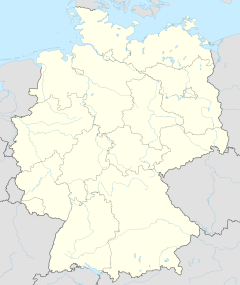
Wuppertal is a city in North Rhine-Westphalia, Germany, with a population of 355,000. Wuppertal is the seventh-largest city in North Rhine-Westphalia and 17th-largest in Germany. It was founded in 1929 by the merger of Elberfeld, Barmen, Ronsdorf, Cronenberg and Vohwinkel, and was initially called "Barmen-Elberfeld" before adopting its present name in 1930. It is the capital and largest city of the Bergisches Land.

The Bergisches Land is a low mountain range in the state of North Rhine-Westphalia, Germany, east of the Rhine and south of the Ruhr. The landscape is shaped by forests, meadows, rivers and creeks and contains over twenty artificial lakes. Wuppertal is the biggest town, while the southern part has economic and socio-cultural ties to Cologne. Wuppertal and the neighbouring cities of Remscheid and Solingen form the Bergisches Städtedreieck.

Elberfeld is a municipal subdivision of the German city of Wuppertal; it was an independent town until 1929.
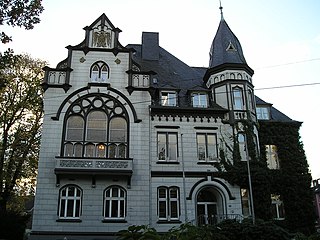
Haan is a town in the district of Mettmann, in North Rhine-Westphalia, Germany. It is situated at the western edge of the Bergisches Land, 12 km southwest of Wuppertal and 17 km east of Düsseldorf. In 1975, Gruiten was incorporated into Haan.
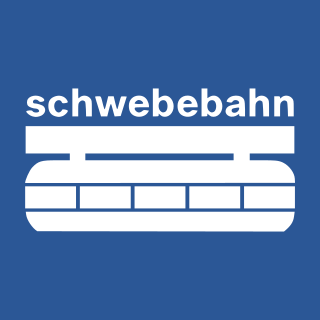
The Wuppertaler Schwebebahn is a suspension railway in Wuppertal, Germany. The line was originally called in German: Einschienige Hängebahn System Eugen Langen named after its inventor, Eugen Langen. It is the oldest electric elevated railway with hanging cars in the world. Being grade-separated, it is considered rapid transit.

The Wupper is a right tributary of the Rhine in the state of North Rhine-Westphalia, Germany. Rising near Marienheide in western Sauerland it runs through the mountainous region of the Bergisches Land in Berg County and enters the Rhine at Leverkusen, south of Düsseldorf. Its upper course is called the Wipper. Both names are related to "weave", and refer to the twisting course.

Hückeswagen is a town in the north of Oberbergischen Kreis, in North Rhine-Westphalia, Germany. It is part of the governmental district of Cologne.

Radevormwald is a municipality in the Oberbergischer Kreis, in North Rhine-Westphalia, Germany. It is one of the oldest towns in the Bergischen Land, formerly the County and Duchy of Berg.

Wuppertaler SV is a German association football club located in Wuppertal, North Rhine-Westphalia. The city was founded in the year of 1880 by the union of a number of smaller towns including Elberfeld, Barmen, Vohwinkel, Cronenberg and Ronsdorf – each with its own football club. Wuppertal Sport Verein was formed on 8.July 1954 out of the merger of TSG Vohwinkel and SSV Wuppertal and was later joined by Borussia Wuppertal to form the present day club. In addition to the football side, today's sports club includes departments for boxing, gymnastics, handball, and track and field.
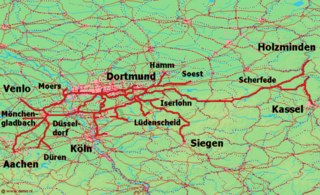
The Bergisch-Markisch Railway Company, also referred to as the Berg-Mark Railway Company or, more rarely, as the Bergisch-Markische Railway Company, was a German railway company that together with the Cologne-Minden Railway and the Rhenish Railway Company was one of the three (nominally) private railway companies that in the mid-19th century built the first railways in the Ruhr and large parts of today's North Rhine-Westphalia. Its name refers to Bergisches Land and the County of Mark.
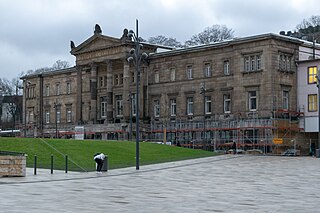
Wuppertal Hauptbahnhof is a railway station in the city of Wuppertal, just south of the Ruhr Area, in the German state of North Rhine-Westphalia. It is on the line between Düsseldorf/Cologne and Dortmund. The 1848 reception building is one of the oldest of its kind. The station was originally Elberfeld station and has been renamed several times since. Since 1992, it has been called Wuppertal Hauptbahnhof. Wuppertal Hauptbahnhof is also the site of lost luggage operations for Deutsche Bahn.
The Düsseldorf-Derendorf–Dortmund Süd railway is a partially closed line in the German state of North Rhine-Westphalia from Düsseldorf-Derendorf station to Dortmund South station. Parts of it are still busy, including two sections used for the Rhine-Ruhr S-Bahn.

Velbert-Langenberg station is located in the city of Velbert in the German state of North Rhine-Westphalia. It is on the Wuppertal-Vohwinkel–Essen-Überruhr line and is classified by Deutsche Bahn as a category 5 station. It was built in 1847.

The Textilfabrik Cromford in Ratingen, North Rhine-Westphalia, Germany was built in 1783 by Johann Gottfried Brügelmann. It was the first cotton spinning mill on the European mainland. Today it is an industrial museum specialising in textile history.

The Baumwollspinnerei Ermen & Engels is a former cotton mill in Engelskirchen, Nordrhein-Westfalen, Germany. It is now part of the LVR Industrial Museum.
Sequin and Knobel, or Séquin and Knobel, were a Swiss firm of architects notable for the design of industrial building such as cotton mills and weaving sheds. It was formed in 1895. The partners were Carl Arnold Séquin and Hilarius Knobel. Together they were responsible for over 250 industrial buildings.
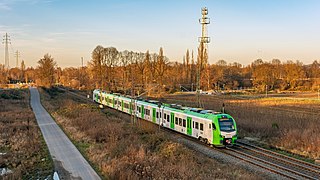
The Wupper-Lippe-Express is an hourly Regional-Express service in German state of North Rhine-Westphalia, which forms part of the Rhine-Ruhr S-Bahn. It connects Wesel with Wuppertal Hauptbahnhof via Oberhausen and Essen.

Karl Gustav Rutz was a German sculptor.

The Wuppertal poets' circle was a literary circle that existed during the 1850s, remaining active into the 1870s and 1880s. The core of the loosely-knit group consisted of seven poets born in or around Wuppertal, Germany: the merchants Reinhart Neuhaus, Emil Rittershaus, Friedrich Roeber, Adolf Schults, Wilhelm Wens, Carl Siebel, Karl Stelter, and the bookseller Hugo Oelbermann. The circle "opposed gloomy Wuppertal Pietism with a free and joyful view of existence."
